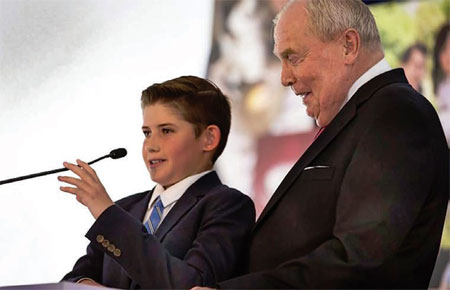On the same day recently that he turned 80 years old, Jon Huntsman Sr., founder of the Huntsman Cancer Institute (HCI) in Salt Lake City, announced the opening of the institute’s new Primary Children’s and Families’ Cancer Research Center that will house researchers focusing on cancer that affects children and runs in families. The unveiling ceremony included a performance by the Mormon Tabernacle Choir and an address by Gov. Gary Herbert, who declared June 19-24 “Cure Cancer Week” in Utah.
The building addition doubles HCI’s research capacity, which, said Huntsman, will help move toward eradicating the disease. Research enhancements include a biotechnology center, complete with the latest advanced genetic sequencing and imaging equipment. Scientists and researchers at the center will leverage the additional space and technology to study the leading disease killer of children, to trace familial cancers, to accelerate the development of new treatments and cancer prevention strategies, and to enhance training programs for the next generation of cancer researchers, officials at the institute said.
At the ceremony Huntsman also announced a new $120 million commitment to HCI from the Huntsman family and the Huntsman Cancer Foundation.
“This new research space is essential to HCI’s mission to relieve the suffering of cancer patients by better understanding cancer and applying that understanding to the development of new ways to treat and prevent cancer,” said Mary Beckerle, CEO and director of HCI. “HCI is more committed than ever to accelerate progress against cancer. We will now be able to expand our research to address the most devastating cancer challenges, including childhood cancers and cancers that run in families. The work we are doing here in Utah will bring comfort and cures to millions of families around the world.”
{mprestriction ids="1,3"}According to a statement from the HCI, the Primary Children’s and Families’ Cancer Research Center will house many unique resources and technologies available to its faculty, including cancer biostatistics, genetic counseling, genomics and bioinformatics analysis, research informatics and the Utah Population Database. With the addition, HCI will have one mile of laboratory bench space. The new building has been designed to promote collaboration among the research teams, including a 120-seat auditorium, 30,000 square feet of contiguous space unifying the cancer population sciences research faculty and public meetings spaces on each floor.
“From the very beginning, our goal has been to build an unrivaled cancer treatment and research campus that is at the forefront of scientific discovery,” said Huntsman. “With this expansion, we’re one step closer to realizing our vision to eradicate cancer from the face of the earth.”
Principal support for the $173 million project was provided by the Jon M. and Karen Huntsman family, Huntsman Cancer Foundation, the Church of Jesus Christ of Latter-day Saints, Intermountain Healthcare and the state of Utah. Throughout its history, more than 1 million individual donors have supported Huntsman Cancer Institute.
“Jon and Karen Huntsman have done more than anyone to bring world-class cancer care and research to Utah,” said Herbert. “Through their kindness, they have offered hope to thousands of patients and their families. This new research facility stands as proof that there is more reason for hope and optimism than ever before.”
The new building addition extends from the southeast corner of the original research area and marks HCI’s fourth major construction phase. The first phase, the Jon M. Huntsman Research Center, was completed in 1999, with three floors of research labs and a floor of outpatient clinics. The second phase, a cancer specialty hospital with 50 inpatient rooms, opened in 2004. In the fall of 2011, a major expansion to the hospital was dedicated, doubling clinical capacity and inpatient rooms.
As the only National Cancer Institute-designated Comprehensive Cancer Center in the Mountain West, HCI serves the largest geographic region in the country, drawing patients from Utah, Nevada, Idaho, Wyoming and Montana.{/mprestriction}








